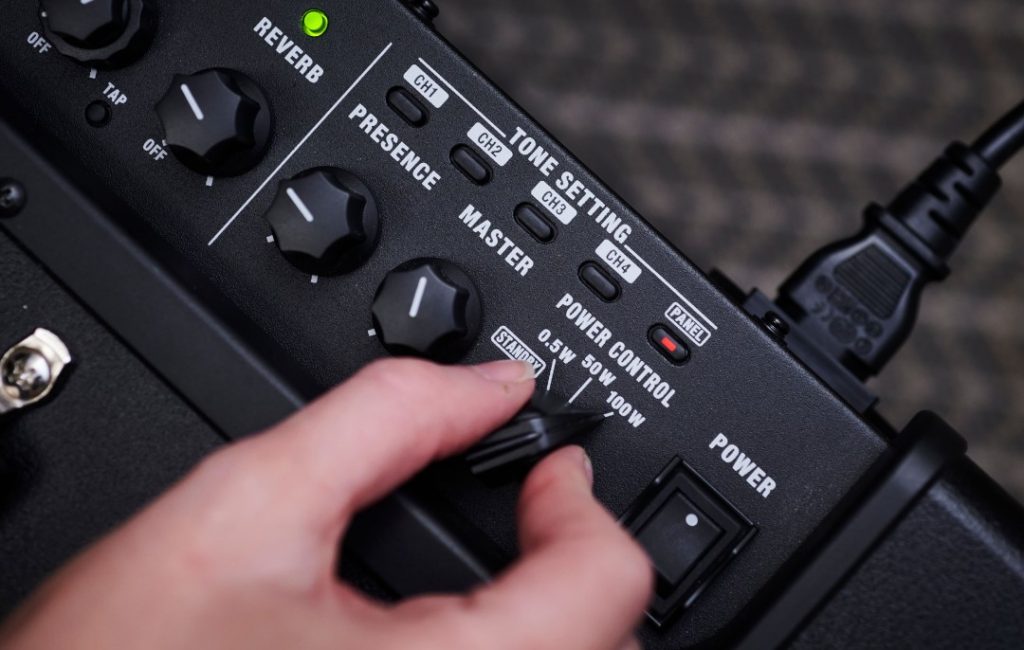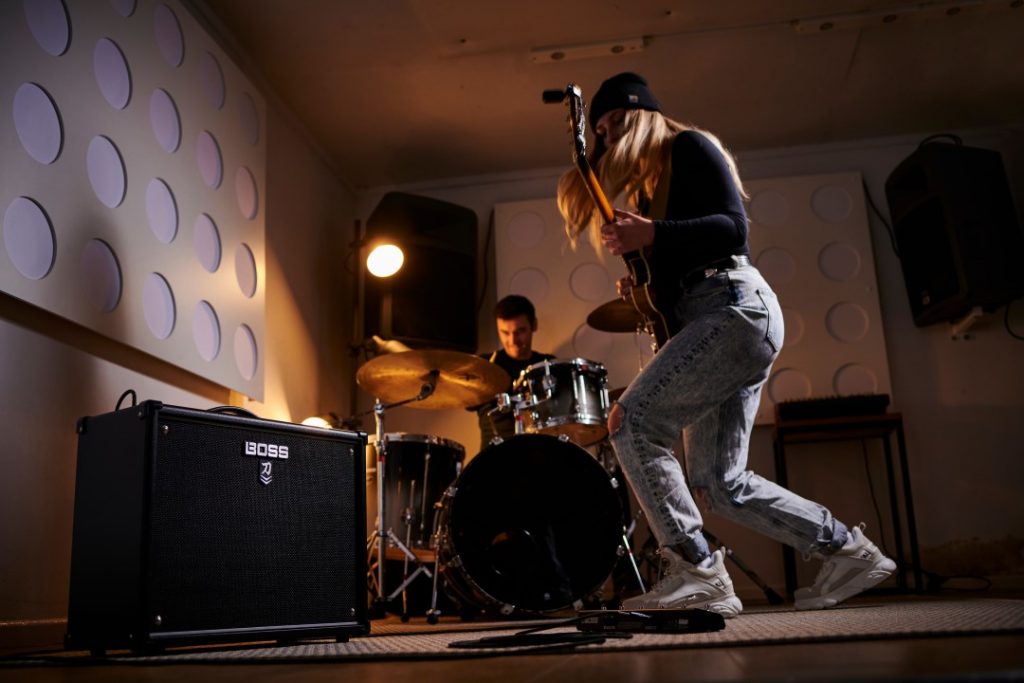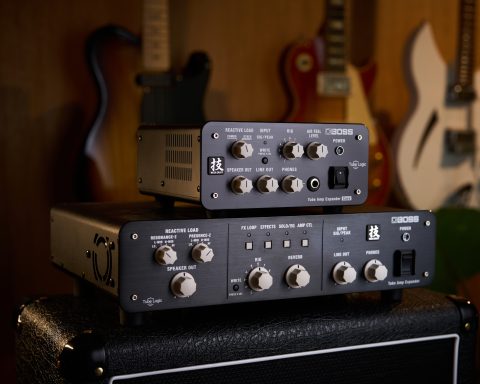For newcomers, the amp market may feel like a confusing world of dials, jacks, inputs, and channels. However, when you strip away the jargon and get to basics, guitar amps don’t have to blow your mind—unless you crank them up. From power outputs to onboard features, this guide will give you the essentials you need to choose an amp with confidence.
AMPLIFIER TYPES
Heart of the Rig
As a guitarist, your amplifier is the center of your setup. Sure, the wood, wire, and magnets of your instrument all make an impact on your tone. But it’s inside that box of tricks where the real magic happens. Transform the unamplified twang of a raw note into a thrash-metal squeal, a creamy blues roar, or anything in-between.
When you walk into a music store for the first time, you might struggle to spot the difference between the models on display. Dig a little deeper and you’ll discover there are significant disparities. Here’s an introduction to the major types.

Combos, Heads, and Cabinets
As a buyer, one of your first big decisions is whether to choose a combo or a head with a cabinet. Combos are more common. They’re the all-in-one cubes you’ll find in every practice space. Combos contain the mechanics, loudspeaker, and controls all within the same enclosure.
Generally chosen by players who need more volume, a head also houses its electronics in the rectangular enclosure. However, because it doesn’t contain a speaker, you’ll need to pair it with a cabinet to get a sound. Many series—like the Blues Cube and Katana—offer combos, heads, and cabs, depending on your budget and how much you want to rock.

Tube Amps
Originating in the ’30s and adopted by ’60s rock gods, tube amps remain a fixture in modern studios and stage rigs. With this type, the guitar signal gets powered and flavored by vacuum tubes. This gives your tone a distinctive character. It’s warm, rich, and nicely rough around the edges as you roll up the volume.
Tubes excel at vintage roar, but they can be expensive, heavy, and troublesome on the road. You’ll have to replace the valves at intervals, too. Old-school examples need cranking to neighbor-baiting volumes to achieve that overdriven sweet spot.
"Combos contain the mechanics, loudspeaker, and controls all within the same enclosure."
Solid-State
Solid-state amps use transistors to amplify the signals instead of tubes. This type offers plenty of advantages for guitarists on any rung of their career. As a rule, solid-state models are available at every price point. They’re also lighter and more practical for gigging than their tube equivalents. In addition, quantum leaps in technology mean they deliver tons of tonal character.

Modeling
As you join bands and experiment with fresh sounds, you’ll need a variety of tones to keep up. Trouble is, even if you could afford every legendary amplifier from rock history, you’d need a hangar to store them. Enter the modeling amp.
These all-in-one numbers use advanced digital technology to replicate the tone, character, and behavior of many amps. Just turn the model selection dial and simulate anything from a ’60s museum piece to a modern metal monster. A serious modeling amp is a highly effective way to get all the sounds you need on a budget. Many even include models of famous pedal effects.
"A serious modeling amp is a highly effective way to get all the sounds you need on
a budget."
Hybrid
If choosing between tube or solid-state is keeping you awake at night, a hybrid amplifier might be a good compromise. Planting a foot in both technologies, these amps set out to offer best-of-both solutions. They combine the organic tone of tubes with the practical advantages of solid-state.
Acoustic Amps
Electric guitar amps take your instrument’s signal and color it. By contrast, an acoustic amplifier keeps your acoustic tone as pure as possible. This way you hear all the subtleties of the wood and natural resonance. That doesn’t mean acoustic amps have to be boring. Choose one of the BOSS Acoustic Singer amps and you’ll get a range of features. These include everything from built-in effects to anti-feedback functionality to eliminate those dreaded squeals.

The Basics
How Do They Work?
Fundamentally, there are three sections to a classic guitar amplifier. After your guitar signal enters the amp through the cable, it hits the preamp. This contains the circuitry that shapes the sound. Alter this by turning the tone dials on the control panel.
Next, the preamp delivers that tidied-up signal to the power amp, which beefs it up with a much higher voltage. Finally, this stronger signal reaches the speaker, which turns the electrical energy into the sound that makes the front row mosh.
"Electric guitar amps take your instrument’s signal and color it. An acoustic amplifier keeps your tone as pure as possible."
What Are Common Features?
While no two guitar amps are alike, there are certain core features you should look for on any credible product. When it comes to the control dials, volume might sound obvious. The further up you turn it, the louder it gets. Still, it’s worth remembering that if the amp also has a gain control, you’ll be able to achieve a distorted tone without blowing the roof off. This is useful in a practice situation.
Short for equalization, EQ controls are important when it comes to sculpting a professional tone. You’ll typically have a dial each for treble, mid, and bass. Experiment with all three to fatten up your sound or give your tone more bite for cutting through.
Whatever your budget, insist on an amp with a headphones output. You’ll typically find this on the back panel. It will become your best friend for late-night practice. If there’s also an AUX socket, even better. This allows you to connect a smartphone or MP3 player and jam along with backing tracks.

What Are Advanced Features?
These days, guitar amps do far more than pump up the volume. If you’ll be switching between clean and distorted tones in the same song, you’ll appreciate a twin-channel amp. For example, dial in a sunny jangle on channel 1 and an edgy grind on channel 2. Then switch between them during the verse and chorus. Of course, you’ll be able to do this much more smoothly if your amp is compatible with a footswitch, like the BOSS Katana series with the GA-FC.
It can get dull to play every riff with the same tone. That’s where effects come in. Many models offer an effects loop, which makes it easy to hook up pedals like BOSS’s famous stompboxes at the optimal point in the signal chain. Even if they’re not modeling amps, most mid/upper-range products also have built-in effects. Reverb is the most common, but many go beyond. Roland’s iconic JC series includes an immersive chorus, while the Katana range gives you access to over 65 BOSS effects.
If you hit on a signature sound, it can also be great to have a store/recall feature. Then you can capture your creations and pull them out fast at a gig.
"Sometimes, you’ll want to blow the roof off, but a great amplifier should also let you dig out a quality tone at bedroom volumes."

What Are Some Practical Extras?
As well as creative features, look out for practical functions when choosing your amp. A line out is invaluable when you start playing more serious gigs. It lets you hook up to a PA system and relay a balanced sound throughout the venue. An onboard tuner is useful if you’re a performer on the move. For even more freedom, investigate wireless amps like the Katana-Air. Its Bluetooth functionality lets you access online musical content, anytime, anyplace.
Sometimes, you’ll want to blow the roof off, but a great amplifier should also let you dig out a quality tone at bedroom volumes. Look out for a Power Control, as featured on the Katana series and other BOSS models. You’ll be able to achieve cranked tones and responses at low volumes that work for shared living.
And remember, a great guitar amp isn’t only about live performance. If you choose one with a USB output, you can send mix-ready tones to your favorite DAW. Start making professional-sounding recordings without paying for studio time.
Can You Use Them for Vocals and Other Instruments?
There are some rules when it comes to mixing and matching instruments and amplifiers. For example, you wouldn’t want to run a bass through a guitar amp, as it won’t provide enough low-end rumble. Similarly, while you can plug an acoustic into a standard electric amplifier, it may sound muddy and create squealing sounds.
However, that doesn’t mean you have to buy separate ones for everyone in the band. Choose an open-ended model that’s designed for multiple instruments. That way you can support guitarists, singers, and keyboard players. The Roland Cube Street EX, has four independent channels. This means you can hook up microphones, guitars, keyboards, and audio devices. Controlling them via an onboard mixer makes it easy to capture a clean sound, even in a busking situation.
Even if you don’t have bandmates yet, that doesn’t mean you’re limited to a one-man strum. Choose the BOSS ACS Acoustic Singer Pro, and you’ll find an onboard looper. Popularized by Ed Sheeran and KT Tunstall, this feature lets you layer up guitar parts. This way, you can create symphonies, even when performing solo.
FIVE QUESTIONS
With so many models competing for your credit card, choosing can be a head-spinning purchase. Before you draw up a shortlist or think about swiping plastic, here are five key questions to ask.
Where Will You Be Using It?
If you want to learn licks in your bedroom or backstage, a good practice amp makes more sense than a stack. On the other hand, if you’ll be playing gigs, look out for features that support performance, from a line out to foot-switchable channels. In the event that you’ve got songs to record, choose one with USB connectivity so it’s easy to capture them on a computer.

What’s Your Budget?
Lack of funds can be frustrating, but it can also help you focus. There’s no top end to the cost of a guitar amp; a vintage tube head can change hands for thousands. Still, the entry-level quality may surprise you. On a budget, you can even snap up a Katana-Mini, an amp that resonates with professional players.
"If you’re not sure what style you'll be pursuing, choose one with open-ended options to go in any direction you choose."
How Much Volume Do You Need?
The golden rule is that wattage refers to power, not volume. Remember that a device with high watts might not be much louder than a lower-rated one. For example, a 100-watt amp is only twice as loud as a 10-watt model, despite being ten times more powerful.
As a rule of thumb, 5-watts is enough for bedroom practice, while over 50-watts will let you compete with a drummer. Keep in mind, that more volume doesn’t equal more gain. A low-powered number with a gain control might suit you better than a beast that needs turning full up.

What Music Will You Be Playing?
Perhaps you’re an old-soul bluesman who’ll be playing pentatonic scales. Maybe you’re a punk who’ll stick with power chords. Let your personality as a musician lead the way. If you’re not sure what style you’ll be pursuing, choose one with open-ended options to go in any direction you choose.
What Kind of Tone Do You Like?
This is the most important question of all. Think about the professional guitarists whose tones make your neck hair stand on end. Then find out what amp they play and use that as your jump-off. If an amp sounds good to you and inspires you to make music, that’s all that matters.






